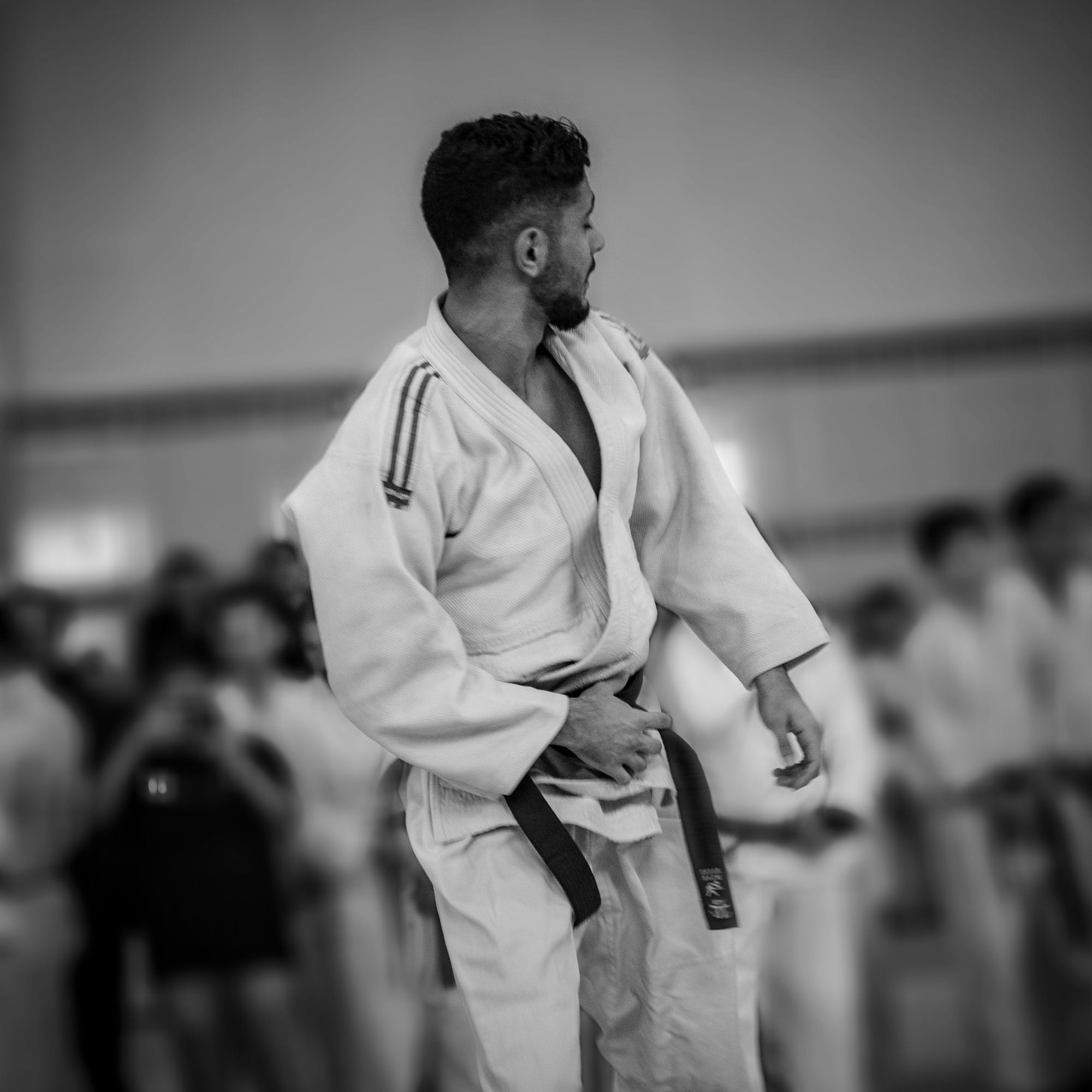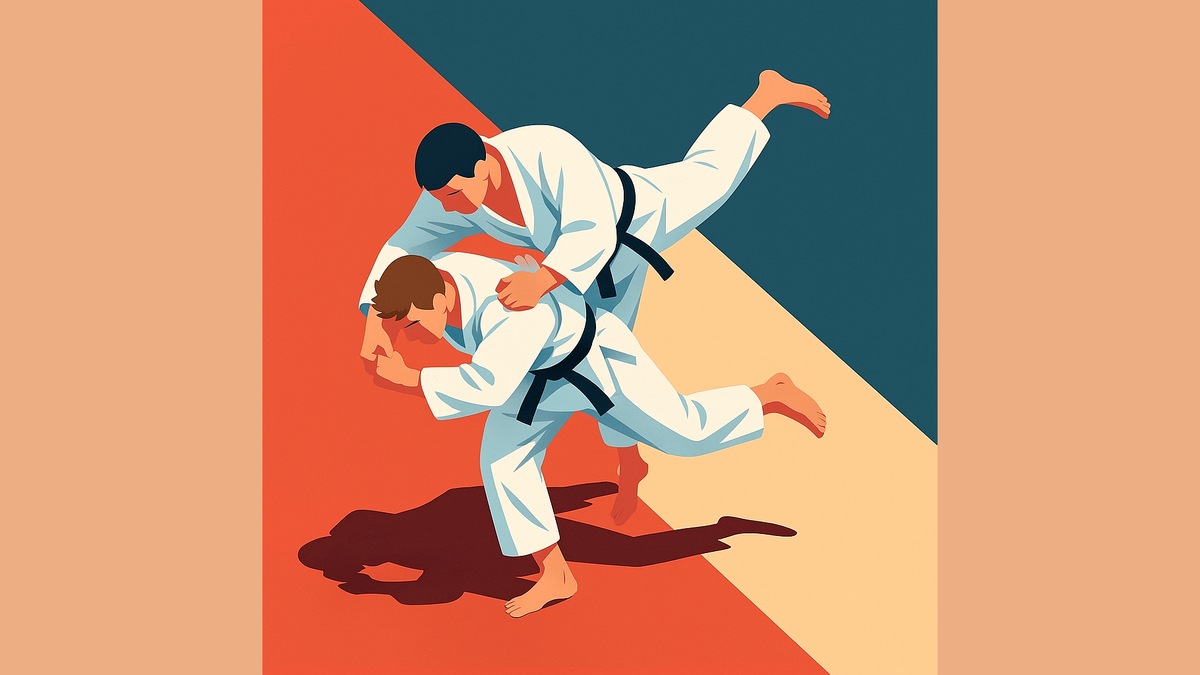What separates a good Osoto-Gari from a match-winning one? At the 2019 World Judo Championships, Hifume Abe sent his Italian opponent airborne with a textbook throw—snapping the body like a whip, dropping him with terrifying grace. It wasn’t brute force. It was biomechanics.
Behind the art of the major outer reap lies a hidden world of physics—a dynamic interplay of balance, torque, and momentum. This isn’t just about form. It’s about how elite judokas quietly manipulate Newton’s laws.
in this NotebookLM podcast, we explore the biomechanics of the judo technique Osoto-gari, also known as the major outer leg sweep. We investigate aspects such as the relationship between head and trunk motion and sweeping leg velocity in skilled practitioners, compare the effectiveness of different knee positions during the sweep, and more.
⸻
Teaching vs. Competing: A Tale of Two Throws
In the dojo, Osoto-Gari is taught in slow, deliberate sequences: extend the arms, tilt the torso, arc the leg. The aim is precision. But under stadium lights? It’s a different story. Competitors condense the setup, attacking with speed and surprise. The throw hinges on a rapid-fire chain reaction—from planted foot to snapping hip to driving arm.
That graceful sweep you mastered in practice? It may crumble under real-time pressure. Can your technique survive chaos?
For a clear, practical breakdown of the fundamentals, check out "Osoto Gari Basics" by Shintaro Higashi. Higashi's detailed explanations highlight the importance of structure and movement efficiency—core principles that align with these biomechanical insights.

⸻
Kuzushi: The Quiet Engine Behind Every Throw
Judo legend Jigoro Kano emphasized kuzushi—breaking your opponent’s balance—the essence of every throw. Yet in many dojos, static uchikomi drills don’t prepare judokas for real-time disruptions. Studies show they miss the critical timing of push-pull actions.
Enter pre-kuzushi: dynamic drills that provoke a reaction before initiating the throw. They mimic combat, training the hands and eyes to outwit balance, not just break it. Because if your partner is still upright after kuzushi, did you really do it?
If your uke is still standing firm after your kuzushi, are you really setting up the throw—or just going through the motions?

⸻
The Sweeping Leg: More Than Just a Hook
The leg sweep in Osoto-Gari isn’t simply a matter of swinging your leg behind your opponent’s; it’s a highly tuned kinetic chain. Black belts demonstrate markedly higher sweeping leg velocities compared to novices, driven largely by powerful plantar flexion—pointing the toes and driving through the ankle.
Further Reading: Imamura, R., Iteya, M. and Takeuchi, Y. (2005) The Biomechanics of Osoto-gari, Association for the Scientific Studies on Judo. Available at: http://150.60.32.66/en/docs/kiyou7imamura47.pdf (Accessed: 23 March 2025).
This small but critical detail maximizes momentum through the kinetic chain, optimizing force transfer from the foot all the way to the opponent’s center of gravity. Think of it as the final crack of a whip; without it, the entire system underperforms.
In short: Your ankle might be the unsung hero of your Osoto-Gari.
For practical ways to fine-tune your throw, including grip variations and footwork nuances, don't miss "Sharpen Your Osoto Gari Throw with These Tips". These strategic adjustments can give your Osoto-Gari a decisive edge.
⸻
Head and Trunk: The Hidden Drivers of Velocity
What if the secret to a stronger sweep lay not in your legs, but in your head and trunk?
Recent research has shown that judokas who tilt their trunk and head sharply forward generate more momentum, aiding both the sweep and the upper-body drive. A jackknife effect emerges: a rapid forward tilt reduces rotational inertia, accelerating the body’s spin and enhancing sweeping-leg velocity.
Further Reading: Liu L, Deguchi T, Shiokawa M, Hamaguchi K, Shinya M. Analysing head and trunk motion in the judo osoto-gari technique: relationship to sweeping-leg velocity. PeerJ. 2025 Jan 23;13:e18862. doi: 10.7717/peerj.18862. PMID: 39866562; PMCID: PMC11766671.
Not only does this position boost mechanical performance, but it also sharpens visual targeting, allowing more precise leg placement. So next time you execute Osoto-Gari, remember: It’s not just legs doing the work—it’s a full-body symphony.

⸻
Angular Momentum: Spinning to Victory
Successful Osoto-Gari depends on generating angular momentum—that rotational force that sends uke sprawling.
Key to this is the Y-axis moment arm: the distance between the system’s center of pressure and center of mass. Ideally, during the throw’s final phase, the center of mass should overtake the center of pressure, creating a negative moment arm. This dynamic generates a powerful counterclockwise torque, amplified by chest-to-chest contact.
Miss the mark here, and you’ll find your throw sluggish and easily countered.
⸻
Knee-Flexed vs. Knee-Extended: Which Sweep Wins?
In beginner judokas, biomechanical analysis reveals that a knee-flexed sweeping leg provides better results: greater stability, higher potential and kinetic energy, and increased sweeping force.
While it may take a fraction longer to complete, the payoff is significant. More powerful sweeps and improved balance make the knee-flexed variant an attractive option, especially for those refining their fundamentals.
Sometimes, bending a little can mean throwing a lot.
Takeaways for the Tatami
- Competition demands speed: Technical perfection alone won’t cut it; streamline your setup to deny your opponent a chance to react.
- Dynamic kuzushi matters: Pre-kuzushi drills better prepare you for real-world balance-breaking.
- Activate the kinetic chain: Plantar flexion in the sweeping leg maximizes your throw’s force.
- Whole-body coordination: Head and trunk tilts aren’t cosmetic; they drive momentum and sweep velocity.
- Understand angular momentum: Aim for chest-to-chest contact and a negative Y-axis moment arm to amplify torque.
- Consider knee flexion: Flexed sweeping legs yield greater power and balance—key for beginners and veterans alike.
Final Thought
If science reveals anything, it’s that judo isn’t about size or brute strength. It’s about hacking gravity.
Next time you step onto the tatami, don’t just move your body. Move the physics.
Question: Why is plantar flexion (pointing the toes) important during the leg sweep phase of Osoto-Gari?
A. It improves the grip strength of the tori
B. It increases the velocity of the sweeping leg
C. It stabilizes the opponent’s center of mass
D. It decreases the required effort to lift the leg
Answer
Correct Answer: B. It increases the velocity of the sweeping leg.
Explanation: Plantar flexion (pointing the toes) engages the ankle effectively, enhancing the kinetic chain and allowing for greater sweep speed and force during Osoto-Gari.
(1) Gomes, Fábio & Meira Jr, Cassio & Franchini, Emerson & Tani, Go. (2003). Specificity of Practice in Acquisition of the Technique of O-Soto-Gari in Judo. Perceptual and motor skills. 95. 1248-50. 10.2466/PMS.95.8.1248-1250.
(2) Gomes, Fábio & Bastos, Flavio & Meira Jr, Cassio & Neiva, Jaqueline & Tani, Go. (2016). Effects of distinct practice conditions on the learning of the o soto gari throwing technique of judo. Journal of Sports Sciences. 35. 10.1080/02640414.2016.1180418.
(3) Liu L, Deguchi T, Shiokawa M, Hamaguchi K, Shinya M. Analysing head and trunk motion in the judo osoto-gari technique: relationship to sweeping-leg velocity. PeerJ. 2025 Jan 23;13:e18862. doi: 10.7717/peerj.18862. PMID: 39866562; PMCID: PMC11766671.
(4) Imamura, R., Iteya, M. and Takeuchi, Y. (2005) The Biomechanics of Osoto-gari, Association for the Scientific Studies on Judo. Available at: http://150.60.32.66/en/docs/kiyou7imamura47.pdf (Accessed: 23 March 2025).
(5) Kuo, K. (2001). COMPARISON BETWEEN KNEE-FLEXED AND KNEE-EXTENDED STYLES IN THE MAJOR OUTER LEG SWEEP. 19 International Symposium on Biomechanics in Sports (2001).
(6) Jagić, Marija & Hraski, Željko & Mejovšek, Mladen. (2005). Comparative kinematic analysis of teaching and competitive performance of the Osoto-Gari throw.
(7) Liu, L. (2020). Measuring and Analyzing the Angular Momentum Produced in the Application of the Judo Throwing Technique Osoto-Gari. 38th International Society of Biomechanics in Sport Conference.





Member discussion: